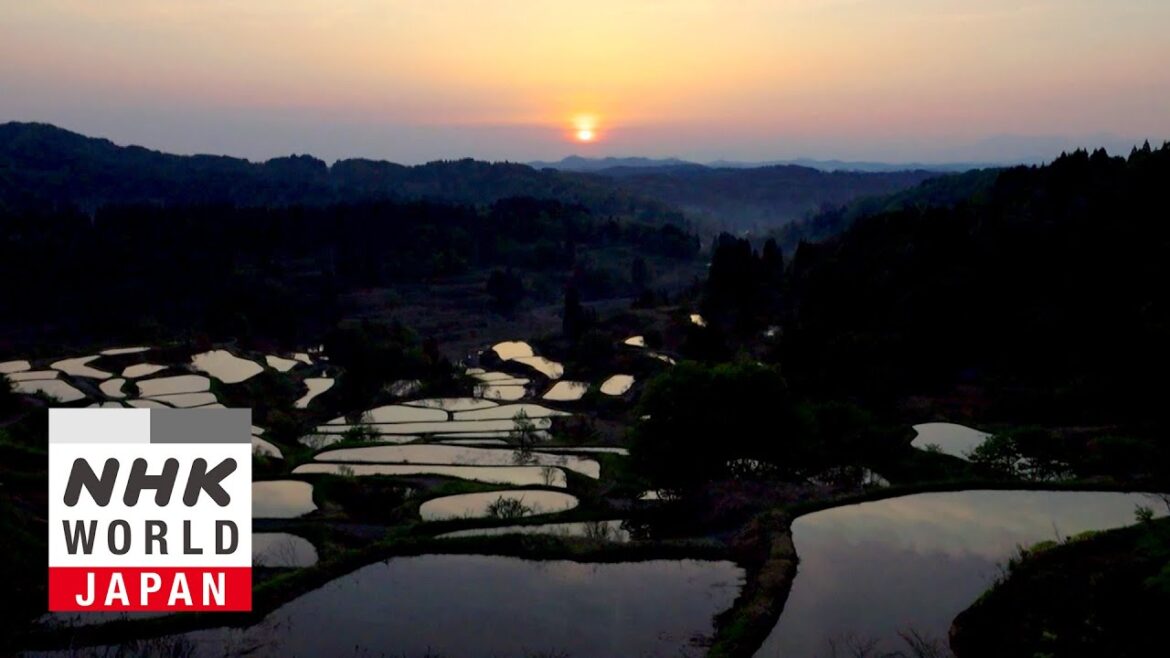NIIGATA – Hit the Road
If you wish to really see Japan, get behind the wheel. Notable places and interesting people are waiting just off the beaten path. Just 2 hours from Tokyo by bullet train lies Nigata Prefecture, our destination for this journey. From Nigata Station, we head south, bound for the terrace rice fields of Hoshito. Built into the mountain sides in step layers, these patties are a timeless image of Japanese rice farming. Nigata is Japan’s top rice growing region. We are sure to find top-notch rice dishes on our drive. Get ready to experience the soul of Japan, one bite at a time. Let’s hit the road. Welcome to Nigata. I’m your navigation system. Let’s kick things off and go taste some of Nigata’s famous rice. Just a 20-minut drive from here is our first stop, Michinoi Aano, known for its incredible rice balls. This is the Aano River. Its pure, abundant waters are what make the local rice so delicious. And here we are. Head in and explore. Enjoy. [Music] Heat. Hey, Heat. [Music] Hey, hey, hey. [Music] [Music] [Music] You should tell Let’s do it. [Music] [Music] [Music] Did you enjoy those oniri? Nigata’s rice thrives thanks to vast flat plains where water can be evenly spread. Just look, the etchigo plane is covered in endless fields of rice. Next, let’s head slightly north to Fukushima Gata Lagoon. One of Nigata’s most scenic spots and closely tied to rice cultivation. On your right is Fukushima Gata Lagoon. At 262 hectares, it’s the prefecture’s largest wetland. This picturesque area is a haven for wildlife. Home to over 450 plant species and visited by some 220 species of birds. [Music] Long ago, this wetland was said to be 22 times larger than it is today. Starting in the 18th century, it was gradually transformed into farmland. [Music] Those reclaimed rice fields are now an essential part of Nigata’s rice production. [Music] The gata in Nigata actually means lagoons, which were once scattered throughout the region. Until about 50 years ago, people still fished here. Life and water were deeply intertwined. To grow rice in wetland conditions, people used their ingenuity. You can still see the results today. These trees were planted to help dry harvested rice. A traditional drying method unique to Nigata designed to hang the rice high off the ground to keep it from getting wet. [Music] Now for something a little more festive. Let’s head southwest to another Michinoi where, believe it or not, you can see fireworks almost every day. [Music] Look, just after this tunnel, the Sea of Japan is coming into view. In winter, clouds forming over this sea bring heavy snowfall, making Nigata one of Japan’s snowiest regions. We’re now heading back inland. On the left is the home of one of Japan’s biggest annual fireworks festivals. It’s been lighting up the sky for nearly 150 years. We’ve arrived. [Music] [Music] [Music] [Music] [Music] [Music] [Music] Fore! [Music] Foreign! Foreign! [Music] Enjoy [Music] the fireworks. The real event takes place in August. Don’t miss it if you have the chance. Now then, up ahead is a special spot where you can try some of Nigata’s beloved local dishes. Michinoi cross 10. Leaving the plains behind, we head into the mountains. We’ve entered Tokamachi, a town nestled in the hills. Come winter, this whole area is transformed by deep snow. Let’s taste the regional cuisine shaped by this unique climate. The Red Building is our destination. Go explore. [Music] for you. Pokemon [Music] What? [Music] [Music] [Music] Foreign [Music] speech. Foreign speech. [Music] [Music] All fueled up, then let’s head to our final destination, Hoshito Terrace Rice Fields, about 30 km deeper into the mountains. See the steps running across the hillside? These are terrace rice patties built into the slopes by leveling sections of land. They’re the result of generations of ingenuity and hard work. We’ve arrived at Hoshito Terrace rice fields. From this spot, you can look out over around 200 rice patties. Only rain water is used to grow rice here. And remarkably, the farming methods and landscape have stayed the same for over 300 years. These mirror-like patties appear just after the snow melts in May. We’ve arrived in the evening, but the most breathtaking view comes at dawn. Let’s fast forward a bit and take in the beauty of sunrise. [Music] [Music]
Explore more destinations in Japan on NHK WORLD-JAPAN!
https://www3.nhk.or.jp/nhkworld/en/shows/category/18/?cid=wohk-yt-2511-htrNiigata-hp
More quality content available on NHK WORLD-JAPAN:
https://www3.nhk.or.jp/nhkworld/en/shows/?cid=wohk-yt-2511-htrNiigata-hp
Get the scoop on Japan’s finest grains while rolling through Niigata, where flavorful sake and rice balls made with locally-grown ingredients can be found around every corner.


AloJapan.com